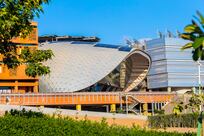Desertec's concept of harnessing renewable energy from deserts dates back to 2003 and was developed by an international network of politicians, academics and economists.
The idea led to the establishment in 2009 of the non-profit Desertec Foundation and of the industrial initiative Dii, which comprises more than 55 companies and institutions including the foundation.
Desertec scientists have calculated in any six-hour period of sunshine, the world's deserts receive more energy than humankind consumes in a year.
Solar-thermal power plants located in deserts can supply electricity on demand day and night thanks to their heat-storage tanks.
Desertec says this makes such plants an ideal complement to fluctuating energy sources such as wind and photovoltaic power and will allow a higher percentage of these variable energy sources to be used in the future electricity mix.
Desertec envisages a renewable energy collaboration between North Africa, the Middle East and Europe that does not just use the desert sun but includes other renewable energies such as wind where their use is most efficient.
As 90 per cent of the world's population lives within 3,000 kilometres of deserts, Desertec says its concept can be realised not only in Europe, the Middle East and North Africa, but also in sub-Saharan Africa, southern Africa, the Americas, Australia, India and in the whole of east Asia, where suitable deserts are well within reach of the centres of power demand.
The project is made feasible thanks to high-voltage direct current (HVDC) transmission.
Unlike conventional AC transmission, HVDC can carry electricity generated from renewables over long distances with losses of just 3 per cent per 1,000km, says Desertec.
Dii is preparing reference projects in Morocco, Algeria and Tunisia that will generate a total of 2.5 gigawatts, with the plant in Morocco aimed at producing 500 megawatts.
The plans for Algeria and Tunisia each amount to 1gw.




